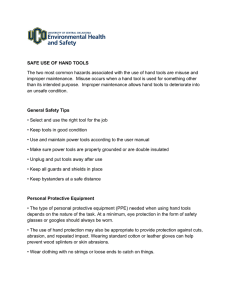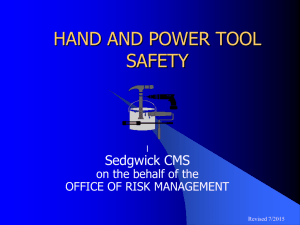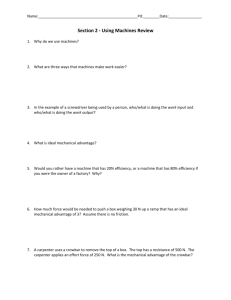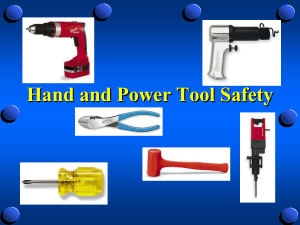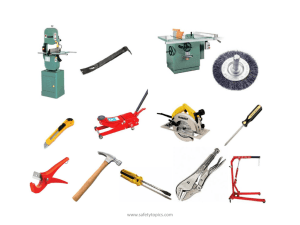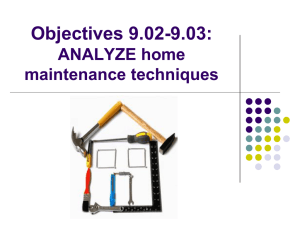Hand Tool Safety
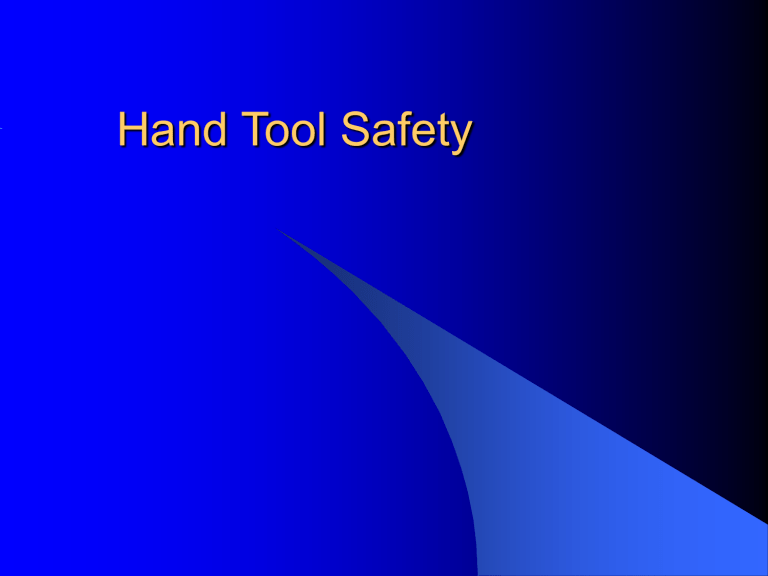
Hand Tool Safety
Introduction
Hand tools can be just as dangerous as power tools and other equipment when not properly used, stored, or maintained.
Your hand tools are an important part of your job, and should be treated, cared-for, and used in a professional manner.
This presentation will help to provide you ways in which you can help to use hand tools in the proper way, so they will be there for you when you need them.
Agenda
Hand Tool Rules
Files & Rasps
Chisels
Hammers
Saws
Screwdrivers
Wrenches
Pliers
Vises
Clamps
Snips
Tool boxes / Chests / Cabinets
Overview
Almost all of us use hand tools--at work and at home. It's estimated that about 8% of industrial accidents involve the unsafe use of hand tools (both manual and power). These accidents result from using the wrong tool for the job (or using the right tool incorrectly), failing to wear personal protective equipment, or failing to follow approved safety guidelines.
Hand Tool Rules
4.
5.
1.
2.
3.
Know the purpose of each tool in your toolbox, and use each for the specific task it was designed to do.
Never use any tool--hand or power-unless you are trained to do so.
Inspect tools before each use and replace or repair if worn or damaged.
Clean tools after every use.
Keep cutting edges sharp.
Hand Tool Rules
1.
2.
3.
4.
Never test a cutting edge with your fingers--test on scrap material instead.
Select the right size tool for the job--don't use cheaters.
When working on ladders or scaffolding, be sure that you and your tools are secure. (A falling tool can seriously injure a coworker or bystander.)
Carry tools correctly--never put sharp or pointed tools in your pockets.
Hand Tool Rules
1.
2.
3.
When hand-carrying tools, point cutting edges away from you, toward the ground.
Lightly oil metal tools and store in clean, dry place to prevent rust.
Wear Personal Protective Equipment
(PPE), such as safety goggles, face shields, gloves, etc. as required.
Hand Tool Rules
Do not continue to work if your safety glasses become fogged; stop work and clean the glasses until the lenses are clear and defogged
Use tied off containers to keep tools from falling off of scaffolds and other elevated work platforms
Carry all sharp tools in a sheath or holster
Tag worn, damaged or defective tools "Out of
Service" and do not use them
Hand Tool Rules
Do not use a tool if its handle has splinters, burrs, cracks, splits or if the head of the tool is loose
Do not use impact tools such as hammers, chisels, punches or steel stakes that have mushroomed heads
When handing a tool to another person, direct sharp points and cutting edges away from yourself and the other person
When using knives, shears or other cutting tools, cut in a direction away from your body
Hand Tool Rules
Do not chop at heights above your head when you are working with a hand axe
Do not carry sharp or pointed hand tools such as screwdrivers, scribes, aviation snips, scrapers, chisels or files in your pocket unless the tool or your pocket is sheathed
Do not perform "make-shift" repairs to tools
Hand Tool Rules
Do not use "cheaters" on load binders or
"boomers"
Do not carry tools in your hand when you are climbing; carry tools in tool belts or hoist the tools to the work area using a hand line
Do not throw tools from one location to another, from one employee to another, from scaffolds or other elevated platforms
Transport hand tools only in tool boxes or tool belts; do not carry tools in your clothing
Files & Rasps
Do not use a file as a pry bar, hammer, screwdriver or chisel
When using a file or a rasp, grasp the handle in one hand and the toe of the file in the other
Do not hammer on a file
Chisels
Use the chisel that has been sharpened; do not use a chisel that has a dull cutting edge
Do not use chisels that have
"mushroomed" striking heads
Hold a chisel by using a tool holder if possible
Clamp small workpieces in the vise and chip towards the stationary jaw when you are working with a chisel
Hammers
Use a claw hammer for pulling nails
Do not strike nails or other objects with the "cheek" of the hammer
Do not strike a hardened steel surface, such as a cold chisel, with a claw hammer
Do not strike one hammer against another hammer
Do not use a hammer if your hands are oily, greasy or wet
Do not use a hammer as a wedge or a pry bar, or for pulling large spikes
Use only the sledge type hammer on a striking face wrench
Saws
Keep control of saws by releasing downward pressure at the end of the stroke
Do not use an adjustable blade saw such as a hacksaw, coping saw, keyhole saw or bow saw, if the blade is not taut
Do not use a saw that has dull saw blades
Oil saw blades after each use of the saw
Keep your hands and fingers away from the saw blade while you are using the saw
Do not carry a saw by the blade
When using the hand saw, hold the workpiece firmly against the work table
Use the circular saw guard when using the circular saw
Screwdrivers
Always match the size and type of screwdriver blade to fit the head of the screw
Do not hold the workpiece against your body while using a screwdriver
Do not put your fingers near the blade of the screwdriver when tightening a screw
Use a drill, nail, or an awl to make a starting hole for screws
Do not force a screwdriver by using a hammer or pliers on it
Do not use a screwdriver as a punch, chisel, pry bar or nail puller
When you are performing electrical work, use the screwdriver that has the blue handle; this screwdriver is insulated
Do not carry a screwdriver in your pocket
Do not use a screwdriver if your hands are wet, oily or greasy
Do not use a screwdriver to test the charge of a battery
When using the spiral ratchet screwdriver, push down firmly and slowly
Wrenches
Do not use wrenches that are bent, cracked or badly chipped or that have loose or broken handles
Do not slip a pipe over a single head wrench handle for increased leverage
Do not use a shim to make a wrench fit
Use a split box wrench on flare nuts
Do not use a wrench that has broken or battered points
Use a hammer on striking face wrenches
Discard any wrench that has spread, nicked or battered jaws or if the handle is bent
Use box or socket wrenches on hexagon nuts and bolts as a first choice, and open end wrenches as a second choice
Pliers
Do not use pliers as a wrench or a hammer
Do not attempt to force pliers by using a hammer on them
Do not slip a pipe over the handles of pliers to increase leverage
When you are performing electrical work, use the pliers that have the blue rubber sleeves covering the handle; these pliers are insulated
Do not use pliers that are cracked, broken or sprung
When using the diagonal cutting pliers, shield the loose pieces of cut material from flying into the air by using a cloth or your gloved hand
Vises
When clamping a long workpiece in a vise, support the far end of the workpiece by using an adjustable pipe stand, saw horse or box
Position the workpiece in the vise so that the entire face of the jaw supports the workpiece
Do not use a vise that has worn or broken jaw inserts, or has cracks or fractures in the body of the vise
Do not slip a pipe over the handle of a vise to gain extra leverage
Clamps
Do not use the C-clamp for hoisting materials
Do not use the C-clamp as a permanent fastening device
Snips
Wear your safety glasses or safety goggles when using snips to cut materials
Wear your work gloves when cutting materials with snips
Do not use straight cut snips to cut curves
Keep the blade aligned by tightening the nut and bolt on the snips
Do not use snips as a hammer, screwdriver or pry bar
Use the locking clip on the snips after you have finished using them
Tool Boxes / Chests / Cabinets
Use the handle when opening and closing a drawer or door of a tool box, chest, or cabinet
Tape over or file off sharp edges on tool boxes, chests or cabinets
Do not stand on tool boxes, chests or cabinets to gain extra height
Lock the wheels on large tool boxes, chests or cabinets to prevent them from rolling
Push large chests, cabinets and tool boxes; do not pull them
Do not open more than one drawer of a tool box at a time
Close and lock all drawers and doors before moving the tool chest to a new location
Do not move a tool box, chest or cabinet if it has loose tools or parts on the top
Summary
Hand tools can be just a dangerous and harmful to the user and others as power tools and equipment, if not used properly.
Hand tool, use, care, maintenance, and storage are an important part of maintenance and custodial departments.
